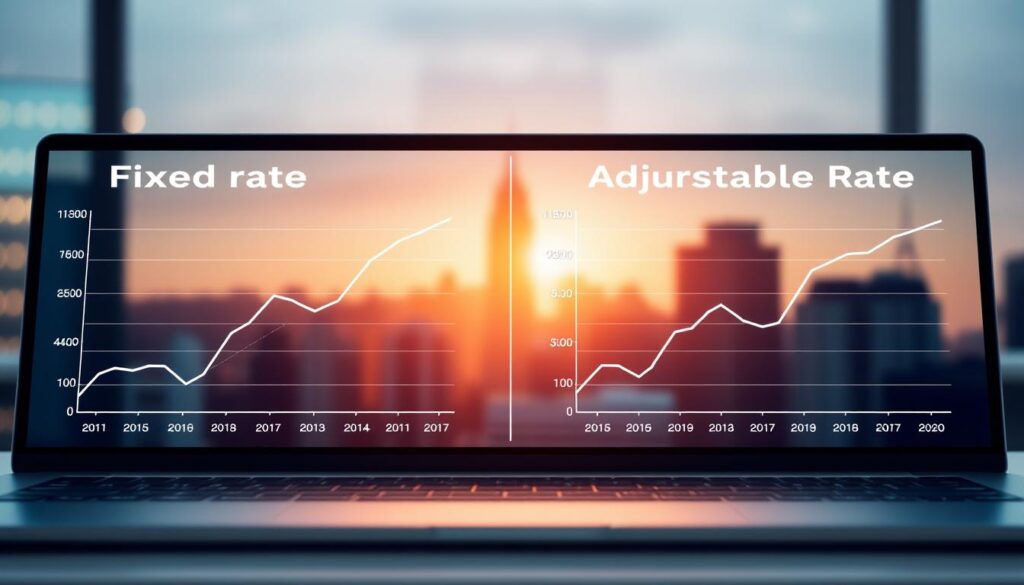Discover Top Home Loan Options in the US
Did you know the average down payment for first-time homebuyers was 9% in 2024? This is according to the Mortgage Research Center. It shows how mortgage rates and home financing options are changing.
When we look at home loans, it’s key to know the different types. Also, understanding what affects best loan rates is important for reaching your goal of owning a home.
We’ll dive into the various mortgage rates and loan options. These can help make owning a home more possible. This way, you can make smart choices.
Key Takeaways
- Understanding the average down payment for first-time homebuyers.
- The importance of knowing various home loan options.
- Factors influencing mortgage rates and best loan rates.
- Navigating the complex world of home financing.
- Making informed decisions for achieving homeownership goals.
Understanding Home Loans: An Overview
Understanding home loans is key for anyone wanting to buy a home. It helps buyers make smart choices about their mortgage. We’ll cover the basics of home loans, including the types and what affects loan eligibility.
What is a Home Loan?
A home loan, or mortgage, is a loan from a mortgage lender for buying or keeping a home. The loan is backed by the property. If the borrower can’t pay, the lender can take the property.
Types of Home Loans Available
There are many home loans for different financial needs. These include:
- Conventional loans
- FHA loans
- VA loans
- USDA loans
Each loan has its own rules and benefits. For example, home equity loan rates matter for homeowners wanting to use their property’s value.
Importance of Credit Scores
Credit scores are vital in the loan approval process. They show lenders how reliable a borrower is, affecting approval chances and interest rates. A good credit score can lead to better loan deals. It’s wise to check your credit report before buying a home to avoid surprises.
Knowing about home loans and keeping a good credit score helps buyers confidently find a mortgage.
Conventional Loans: A Popular Choice
Conventional loans are a top pick for home financing. They’re not backed by the government, unlike other home loans.
Features of Conventional Loans
These loans offer flexibility in loan amounts and repayment terms. They can be conforming or non-conforming. Conforming loans follow the Federal Housing Finance Agency (FHFA) limits.
- Conforming Loans: These loans meet the FHFA’s loan limits. They’re eligible for purchase by Fannie Mae and Freddie Mac.
- Non-Conforming Loans: These loans go beyond the FHFA’s limits. They’re often called jumbo loans and have stricter rules.
Eligibility Requirements
To get a conventional loan, you need to meet some criteria. This includes a minimum credit score and down payment.
- A credit score of 620 is usually needed. A higher score can get you better loan terms.
- You’ll need a down payment. A 20% down payment is standard to avoid Private Mortgage Insurance (PMI).
Pros and Cons
Conventional loans have their perks. They might have lower mortgage rates and the chance to cancel PMI when you have enough equity. But, they can be harder to qualify for than government-backed loans.
- Pros:
- Potentially lower mortgage rates
- Option to cancel PMI
- Variety of loan terms available
- Cons:
- Stricter qualification requirements
- Higher down payment needed for better terms
Knowing the details of conventional loans helps you make smart choices. By looking at the pros and cons, you can decide if a conventional loan fits your needs.
FHA Loans: A Government-Backed Option
FHA loans are a special kind of mortgage backed by the government. They help people buy homes, even if they can’t get regular loans. This is great for first-time buyers or those with lower credit scores.
What is an FHA Loan?
An FHA loan is insured by the Federal Housing Administration (FHA). It’s made to help people own homes. You need less money down and can qualify with a lower credit score than regular loans.
Benefits of FHA Loans
FHA loans have many perks. You can put down as little as 3.5% of the home’s price. And, you only need a credit score of 580 to qualify. This helps first-time buyers a lot.
They also let you borrow more money compared to your income. This is because they have more flexible rules about debt.
Key benefits include:
- Lower down payment requirements
- More lenient credit score criteria
- Flexible debt-to-income ratios
FHA Loan Qualifications
To get an FHA loan, you need to meet some rules. You must have a credit score of at least 580. But, some lenders might accept lower scores if you meet other conditions.
The down payment can be just 3.5% if your score is over 580. You also need to show you have a steady income. And, you’ll have to pay for mortgage insurance, which adds to the loan’s cost.
Working with a mortgage lender who knows FHA loans well is crucial. They can help you through the application process.
VA Loans: Supporting Veterans
VA loans help veterans and active-duty service members buy homes with good terms. These loans are backed by the Department of Veterans Affairs. They offer benefits that make home buying easier.
Who is Eligible for VA Loans?
VA loans are for:
- Active-duty service members
- Veterans
- Surviving spouses of veterans who have not remarried
To qualify, you must meet certain service requirements. The VA also looks at your credit and ability to repay the loan.
Benefits of VA Loans
VA loans have attractive benefits, such as:
- Lower interest rates than conventional loans
- No down payment needed in most cases
- Lower mortgage insurance costs
- More flexible credit score requirements
These perks make VA loans a great choice for those who qualify. They can lower the costs of buying a home.
How to Apply for a VA Loan
The VA loan application is like other mortgage applications but needs extra steps. Here’s a quick guide:
- Use the VA’s online tools or talk to a VA-approved lender to check if you qualify.
- Get the needed documents, like your Certificate of Eligibility, proof of income, and ID.
- Apply for pre-approval to know how much you can borrow.
- Find a home and make an offer.
- Finish the loan application, which includes appraisal and underwriting.
Choosing a mortgage lender with VA loan experience can make things easier. It helps ensure a smooth process.
USDA Loans: Rural Development Financing
The USDA loan program helps make home buying easier in rural areas. It’s a government-backed effort to support rural development. We’ll look into USDA loans, who can get them, and their good and bad points.
Overview of USDA Loans
USDA loans help low- to moderate-income buyers in rural areas. They’re backed by the USDA and offer no down payment. This is a big plus for those without enough money for a down payment.
These loans are for homes in USDA-defined rural areas. The goal is to help those who can’t get regular loans. This way, rural development gets a boost.
Eligibility Criteria
To get a USDA loan, you must meet certain criteria. You need to fit within income limits and live in a rural area. These rules vary by location.
Applicants must be U.S. citizens or eligible non-citizens. They should have a steady income and be able to pay the mortgage. The property also has to meet USDA standards.
Key Eligibility Factors:
- Income limits based on location
- Property must be in a USDA-designated rural area
- Applicant must be a U.S. citizen or eligible non-citizen
Benefits and Drawbacks
“USDA loans are great for those who qualify,” says a mortgage expert. But, it’s important to consider the downsides too. These include where you can buy and income limits.
The good things about USDA loans are:
- No down payment needed
- Lower mortgage insurance costs
- 100% financing possible
The not-so-good things are:
- Income limits apply
- Property must be in a USDA-designated rural area
- Funding fees might be there
It’s key for homebuyers to check if they qualify and think about the pros and cons before choosing a USDA loan.
Knowing about USDA loans helps homebuyers decide if they’re the right choice. It’s all about understanding the criteria and the benefits and drawbacks.
Fixed-Rate vs. Adjustable-Rate Mortgages
Choosing between a fixed-rate and adjustable-rate mortgage depends on your financial goals and how much risk you’re willing to take. Both types have their good and bad sides. It’s important to know these before you decide.
Understanding Fixed-Rate Mortgages
A fixed-rate mortgage has the same interest rate for the whole loan term. This means your monthly payments stay the same. This can be great when interest rates are going up.
Key Benefits:
- Predictable monthly payments
- Protection from rising interest rates
- Simplified budgeting
But, fixed-rate mortgages might start with higher interest rates than ARMs. Using a loan calculator can help you see the total cost over time.

Features of Adjustable-Rate Mortgages
Adjustable-rate mortgages (ARMs) have rates that can change with the market. They often start with lower rates than fixed-rate mortgages. But, rates could go up over time.
Potential Drawbacks:
- Uncertainty in monthly payments
- Risk of rising interest rates
- Complexity in understanding rate adjustments
ARMs might be good if you plan to refinance or sell before the rate changes. Knowing about refinancing options and mortgage rates trends can help you decide.
| Mortgage Type | Initial Interest Rate | Monthly Payment Stability |
|---|---|---|
| Fixed-Rate | Typically higher | Stable |
| Adjustable-Rate | Often lower | Variable |
Choosing the Right Option for You
When picking between fixed-rate and adjustable-rate mortgages, think about your finances, future plans, and how you feel about rate changes. A loan calculator can help you see how different choices compare.
“The key to choosing the right mortgage is understanding your financial goals and how different mortgage products align with those goals.”
Choosing between fixed-rate and adjustable-rate mortgages should be based on a deep look at your finances and goals. By considering mortgage rates and refinancing options, you can make a choice that fits your needs.
Home Equity Loans and Lines of Credit
Tapping into your home’s equity can be a smart financial move. It offers funds for various needs through loans and lines of credit. Home equity loans and lines of credit let homeowners use the value they’ve built in their property. This provides a financial safety net or funds for big expenses.
What is a Home Equity Loan?
A home equity loan lets homeowners borrow a lump sum of money. They use the equity in their home as collateral. This loan is repaid over a fixed term with a fixed interest rate, offering predictable monthly payments.
Home equity loans are often used for major expenses. This includes home renovations, paying off high-interest debt, or covering education costs.
How a Home Equity Line of Credit Works
A home equity line of credit (HELOC) is different from a home equity loan. Instead of getting a lump sum, a HELOC offers a revolving credit line. Homeowners can draw upon this line as needed, up to a certain limit.
This flexibility allows homeowners to use the funds for ongoing expenses or projects. This includes home improvement projects that happen over time. Interest is only paid on the amount borrowed, and the interest rates can vary.
When to Consider These Options
Homeowners should think about home equity loans or lines of credit when they need a lot of money. They should have a lot of equity in their property. These financial tools are great for consolidating high-interest debt into a lower-interest loan or financing home improvements that boost the property’s value.
It’s key to evaluate your financial situation carefully. Consider the loan approval process and available best loan rates before deciding.
By understanding home equity loans and lines of credit, homeowners can make smart choices. They can use their home’s equity to reach their financial goals.
Tips for Choosing the Right Home Loan
There are many home loan options out there. It’s important to know which one is best for you. The right home loan can greatly affect your finances and your experience as a homeowner.
Assessing Your Financial Situation
Before looking at home loans, check your finances. Look at your income, expenses, savings, and credit score. A loan calculator can show you how much your mortgage payments will be and if they fit your budget.
As Forbes advises, “Knowing your financial health is crucial for smart home loan choices.”
Researching Loan Providers
It’s important to research mortgage lenders to find the right loan. Look for lenders with good interest rates, flexible terms, and great customer service. Check online reviews, ask for referrals, and compare websites to learn more.
For details on the various loans out there, visit Consumer Finance.
Comparing Different Loan Offers
After finding potential lenders, compare their offers. Look at interest rates, fees, and repayment terms. Think about both the short and long-term effects of each loan.
“The key to finding the right home loan is to compare as many options as possible and consider your long-term financial goals,” says a financial expert.
By understanding your finances, researching lenders, and comparing offers, you can make a smart choice. This will help you pick the best home loan for your needs.

The Home Loan Application Process
Now that we’ve looked at different home loan options, it’s time to go through the application process. Knowing the steps can make your experience smoother and boost your approval chances.
Preparing for Your Application
To begin, collect important documents like pay stubs, W-2s, and tax returns. This step is key for a smooth loan approval. We suggest having these documents ready to prevent delays.
Necessary Documentation
You’ll need identification, proof of income, and credit reports. Having these documents ready makes the application process more efficient.
Closing the Loan
In the loan closing process, you’ll finalize your mortgage agreement. It’s crucial to review the terms, including mortgage rates and refinancing options. This ensures they match your financial goals. Understanding these details helps you make better decisions about your home loan.









